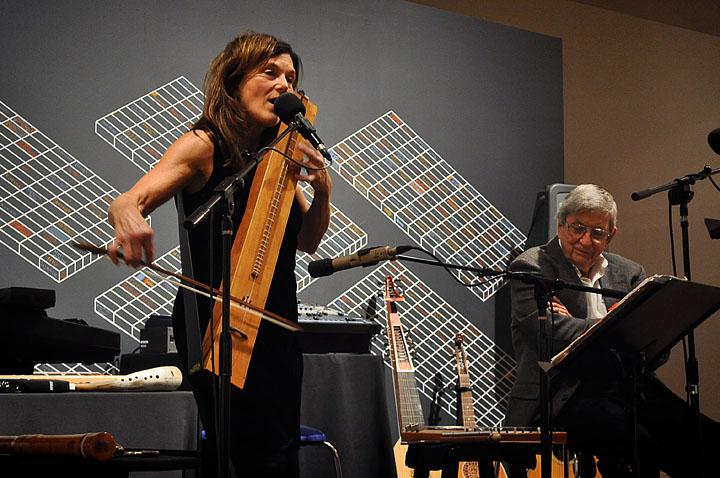He began at the beginning. He spoke of a time before humanity, before words, before all that we call home and all that we call ours existed. While he spoke, she played on a Native American flute—a haunting melody that was brewed on the prairies and amongst the rolling hills of the Mississippi River Valley.

“Stories of Music/Stories of Home” demonstrated the power that both music and language have over our cultural identities—the dancing notes intertwined with profound words created a feeling of place and of home.
Gary Holthaus, poet and essayist, and Lauren Pelon, musician and music historian, created a meditative atmosphere in Falconer Gallery Tuesday night. The event was part of of the current exhibit at the Gallery,“Culturing Community: Projects about Place.” A handful of campus and community members attended the performance.
“[It was] a little weird at first, but it was interesting … it was entertaining and thought-provoking,” said Madeleine Garvey ’12.
Pelon used many instruments to create a certain ambience for each piece, including the pedalboard, bowed psaltery, gemshorn, bass recorder, eagle bone flute, psalmodikon, concertina,, pennywhistles, cornamuse, shawm, ch’ajch’as, guitar and an electric wind instrument.
“I was really surprised by the variety of instruments. I had no idea we’d have all of this packed into one evening,” said Martha Davis, a resident of Des Moines.
Holthaus explained that the goal of the program was to inspire others to think about their roots.
“I try to bring what I have learned from personal experience, from reading and studying. … [We want] to help people think about their own stories, the places they grew up, where they may feel the most at home, even thirty years later,” he said. “[I want to] get folks to think about what home means and how we take care of it.”
The performance was a careful balance between written word and music, as demonstrated by Pelon’s ability to place her musical interludes at the precise point when the audience was comprehending the grand concepts of Holthaus’ writing. At those moments, her instruments filled the sudden silence and caused a mass catharsis in the gallery.
Holthaus’s reading created a narrative arc that emphasized origins, transitions and a final destination. He started with the glaciers hollowing out a river bed, forging a path that would become the iconic Mighty Mississippi. Pelon’s music accentuated the lives of people who came and went long before us.
“The stories that were read and the music complimented each other,” Davis said.
Holthaus and Pelon worked through the steady evolution of the earth and the development of people until they shifted into a piece entitled “The Coming of Music.” This transition from pure nature to practiced culture was set against a background of the Largo from Dvorak’s “From the New World” symphony.
Finally, Holthaus concluded the performance with a series of essays about the steps we must take to find our way “home.” The power of their performance lay in the universality of the message—the concept of home that both artists referenced is different for each listener. Pelon and Holthaus emphasized the importance of having a home, a place in life, whether theoretical or physical, that defines who you are and who you want to be, without identifying a particular culture that could alienate some audience members. Home is complicated, but the unique genius of this program is that it encompassed all of those jumbled up, complex feelings simply and meditatively. It was like coming home.





























































Jacob • Oct 8, 2010 at 1:13 pm
This is amazing! I’m so proud of Kelsey (author)!